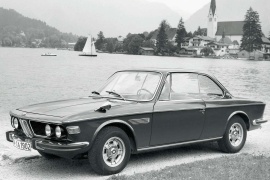BMW 2800 CS Models/Series Timeline, Specifications & Photos
First production year: 1968
Engines: Gasoline
Body style: Coupé (two-door)
This was the beginning of BMW's revival in the grand touring arena, with a coupe meant for long travels in comfort and style, and later on, evolved into one of the most iconic race cars ever created by the German automaker.
BMW introduced a replacement for the 2000 C (coupe) of the Neue Classe (New Class) lineup in 1968. This time, it focused more on the car's performance. It made that very visible on the exterior through the sharp-looking bodywork penned by Wilhelm Hofmeister. The E9 was also a direct hit against Mercedes-Benz, the automaker that didn't want to save the Munich-based brand just a few years earlier.
The front fascia featured a quad-headlight design. It aimed at the significant U.S. market, so it had to have these types of headlights due to American legislation. From its profile, the long hood was designed to accommodate inline-six engines, so the car could provide more power for its customers. The greenhouse featured a raked windshield and retractable B-pillars. At the same time, at the back, the C-pillars formed the already famous Hofmeister-kick design element.
Inside, the automaker installed a pair of bucket seats at the front and a bench in the rear profiled for two occupants. The dashboard looked interesting for those times, with a distinct instrument cluster in front of the driver, followed by a shelf above the center stack and in front of the side passenger. In addition, customers had the option for a leather-wrapped interior, while the standard version came fitted with cloth seats.
Under the hood, the 2800 CS featured a carbureted inline-six engine that sent its power to the rear wheels via a four-speed manual or, as an option, a three-speed automatic.
